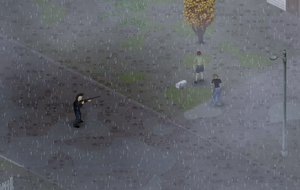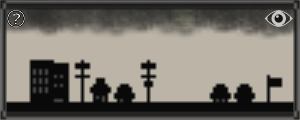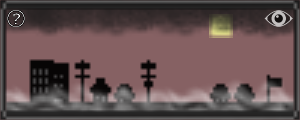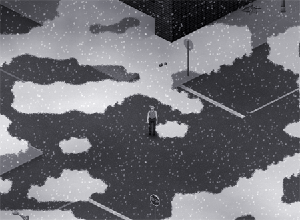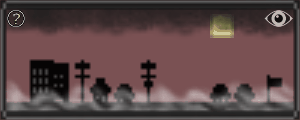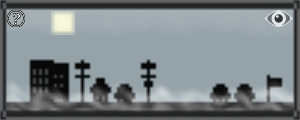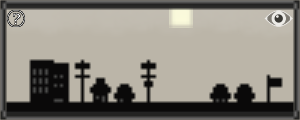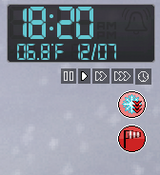Clima
O clima afeta diversos sistemas, incluindo farming/pt-br, foraging/pt-br, health/pt-br do jogador. Project Zomboid utiliza um sistema de clima randomizado e realístico, baseado no clima úmido subtropical de Kentucky. Existem quatro estações diferentes, cada uma com suas próprias variações. Alguns invernos podem atingir temperaturas extremamente baixas, com grandes quantidades de neve, enquanto o oposto é válido para o verão, porém varia com cada nova estação.
Frentes climáticas
O clima é altamente influenciado por frentes climáticas, que podem ser tanto frias (massa de ar baixa) quanto quentes (massa de ar alta), cada uma é acompanhada com suas próprias características climáticas. A intensidade do clima é um resultado da força da ultima frente e da frente atual. Por exemplo, se a última frente foi uma frente quente intensa, e a atual é uma frente fria, haverá uma chance maior de uma tempestade tropical ocorrer. Cada frente dura entre alguns dias a múltiplas semanas.
Climas
Existem vários tipos de clima em Project Zomboid, todos são determinados pela frente climática atual. O jogador pode experienciar climas nublados, chuvosos, gelados, tempestuosos, enevoados, ventosos e ensolarados.
Nublado
As nuvens podem variar em densidade, comumente tendo grande efeito na luminosidade dos exteriores. Nuvens isoladas são normalmente associadas com uma frente quente, reduzindo a luminosidade. Dias muito nublados podem acontecer durante uma frente fria, cobrindo o mundo na escuridão por pequenos períodos. A cobertura atual de nuvens pode ser vista no chão, ou até mesmo nas reflexões em janelas de veículos. Nuvens são representadas no céu da janela de "investigar área", com sua intensidade variando entre inexistente e progredindo do branco ao cinza escuro.
Chuva e Neve
A chuva, ou precipitação, pode ocorrer de diferentes formas, desde breve garoas a tremendas chuvas. Garoas comumente ocorrem após uma frente quente ter passado, já que isso normalmente ocasionará em nuvens isoladas. Já a chuva forte é normalmente associada com uma frete fria, mas pode também acontecer durante frentes quentes. A chuva vai criar poças, gradualmente aumentando em tamanho com base na intensidade da chuva. As poças não tem efeito na tração de vehicles/pt-br. Poças são uma fonte natural de water/pt-br, permitindo que o jogador beba ou encha containers de água. Entretanto, a água estará contaminada. Poças vão lentamente dissipar após a chuva ter parado.
Rain will gradually fill up rain collector barrels and water containers capable of collecting rain water, so long as they are outside in the rain. Rain will also automatically water crops and eventually extinguish a campfire, which can be countered by adding more fuel.
During winter, the temperature can be cold enough for snowfall to occur rather than rainfall. During snowfall, the ground, trees and other surfaces will gradually become covered in snow. Snow will stay on the ground so long as the temperature is less than 0 °C (32 °F). Once above 0 °C (32 °F), the snow will gradually melt. Snow also doesn't have any effect on vehicle traction.
Rain and snow is represented on the "Investigate Area" window, with a white haze close to the ground and dark gray clouds. Many items become harder to find during the rain, with some being easier to find, such as worms and frogs. Many items are even easier to find shortly after it has stopped raining, rather than during the rain, such as mushrooms. Likewise, some can be harder to find after it's stopped raining, such as medicinal plants (plantain, wild garlic, etc.). Snow will negatively affect most items, particularly plants, such as bell peppers, bananas, or basic items like stones.
If the player is caught in the rain or snow, their clothing will become wet, starting with outer layers and gradually moving inwards, until all clothing is wet. This will eventually make the player wet, increasing in severity depending on the level of rainfall and time spent in the rain. Staying wet, in combination with temperature and wind, will cause the player to feel colder and may eventually catch a cold, causing them to involuntarily cough and sneeze. The rain can be blocked by having an open umbrella equipped, keeping the player dry. Once wet, a clothes dryer can be used to dry clothing and a dish towel or bath towel used to dry the player.
The severity of the rain and snow will affect the player's visibility arc and distance. This will also affect the zombies ability to see and hear the player.
Thunder clouds and tropical storms
Thunder clouds may form during a cold front, with the intensity varying with the level of air mass. A colder front (lower air mass) moving into a warmer body (higher air mass) will have a greater chance of producing thunder or even a tropical storm, in which has a lot more wind power, thick clouds and darkness. Thunder is represented on the "Investigate Area" window with flashes of light.
Zombies are attracted to the sound of thunder.
On multiplayer servers, a rumble of thunder can be heard, even if it's clear sunny skies. This is the result of a player being banned from the server.
Fog
Fog, like light showers and widespread cloudiness, is often formed during a warm front. However, fog can also appear during cold mornings, which will usually result in a clear sunny day. Fog can severely affect the player's visibility, making it somewhat dangerous to scavenge during a foggy day. Fog, like rain, can only be seen outdoors, making it safer to stay indoors when it's foggy. Fog is represented on the "Investigate Area" window with a white haze close to the ground.
Sunny
Sunny days are caused by the absence of clouds, often being the result of a cold front. Clear skies are often accompanied by higher temperatures, increasing the player's risk of getting hyperthermia. The intensity of a sunny day can be determined by the intensity of the reddish hue when outside or the absence of any other weather effects in the "Investigate Area" window. The effects of a sunny day can be reduced by removing some clothing or staying indoors.
Wind
Wind can be observed during any time of the year via the weather effects, movement of foliage, rain and snow direction, or even the cloud movement direction. During winter months, windchill becomes a major effect on the player when outdoors. Windchill will cause the player to feel colder than the actual air temperature, as is displayed on a digital watch. Clothing type can reduce the amount of windchill experienced by the player.
Temperature
The temperature in Project Zomboid can vary greatly depending on the current season. Temperature is influenced by several factors, including the season, time of day, wind strength, and air mass, in which determines the weather front. The weather front will determine the maximum and minimum temperature for each day, with the temperature increasing until it reaches the day's maximum temperature, at which point it will begin to fall until it reaches the minimum temperature.
Seasons
There are four distinct seasons: summer, winter, autumn, and spring. Each season has its own unique weather and temperature traits.
Summer
June - August
Summer is typically the hottest season, able to reach temperatures up to and beyond 40 °C (104 °F). Although the typical summer will see very little rainfall, scattered clouds and daytime temperatures averaging 30 °C (86 °F). However, each summer can be very different from the last, with some seeing lower temperatures and more rainfall. Daylight in the summer is the longest of the seasons.
Summer is also the canonical starting season in Project Zomboid, as the Knox Event started on the 4th of July, and the game starts on the 9th of July by default.
Autumn
September - November
Autumn generally has the most extreme weather, having a higher chance of generating tropical storms in the earlier months. Plant life will lose their leaves during these months and may even see snow during the later months. Farming will have a very low yield during autumn.
Winter
December - February
Winter is the coldest season, with temperatures often getting into the negatives and down to -30 °C (-22 °F). Snowfall is most likely to occur during winter, creating snowfields and covering surfaces and plant life in snow. Farming will result in limited yields during these months, with many foragable items impossible or harder to find, plants in particular. Of all the seasons, daylight is shortest during winter.
Spring
March - May
Spring is the most average season, with frequent rain, chance of storms and the most likely to see fog. This season is abundant with wildlife, with foraging and farming yielding plenty of food and resources.
Moon cycle
The moon cycle is based on a 30-day cycle with 8 different moon phases. Each moon phase provides a different amount of ambient light during nighttime, ranging from 0.0 (New Moon) to 0.7 (Full Moon). The current moon phase can be determined via the "Investigate Area" window.


